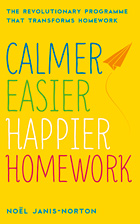Here is an excerpt from “Calmer, Easier, Happier Homework” by Noël Janis-Norton
(published by Hodder & Stoughton, 2013):
Read to your child
Reading to our children is the most effective, as well as the easiest, quickest and most enjoyable, way to improve reading comprehension.
Unless your child is a very skilled and confident reader, the books she is likely to choose to read for her own pleasure usually will not be particularly challenging. They will probably be within the comfort zone of words she can read without a struggle.
But when we read to a child, we can choose more challenging material. Your child will understand the meanings of many words when she hears them in the context of the story, even though she might well have difficulty reading them on her own.
Similarly, children can understand much more complex sentence construction when they are being read to because their brain is engaged in only one task, namely, making mental pictures of what they are hearing. But when children are reading more challenging material, a good part of their working memory must be occupied with the task of decoding, leaving less room for thinking about the ideas and making connections.
So continue the cosy, delightful ritual of reading to your child, even after he has become a good reader. Here are some important guidelines that will make the experience enjoyable and rewarding for both of you and that will result in much improved comprehension. Some of the following guidelines may seem obvious, but others may be new to you:
- As with all habits we want to establish, short daily reading aloud sessions are far more effective than longer but less frequent ones.
- Do not limit reading aloud to your children to the usual time slot just before bedtime.
-
During or right after dinner is another good time because you already have a captive audience.
- Always have a book or two in your handbag or in the car so that you can read aloud while you are waiting around for an after-school activity to begin.
- Keep a basket of books in a prominent spot, such as on the coffee table or near the television.
- If one child is ready to leave the house before the others are, reward him with five or ten minutes of reading aloud.
- And, of course, Special Time (see Chapter 6) is a perfect opportunity for reading aloud.
- Make sure that your child is physically comfortable. Otherwise he will feel restless and his attention may wander. He may even complain that the book is “boring”.
- To maximise your child’s concentration, make sure that nothing else is competing for his attention. In particular, he should not be able to hear any screens on in the background as that would be highly distracting for him.
- Start by exploring with your child the front and back cover of the book. Show your child all the interesting information about the book that he can glean from this, even before you start reading. This will help your child to become familiar with authors and illustrators. Read the blurb and together talk about what you can predict from it. Also, talk about what you each may already know about the story.
- If the book contains drawings or photographs, flick through the book and examine them together, seeing what information you can both extract. This usually whets a child’s appetite for the book.
Reducing resistance to being read to
Sometimes a child seems uninterested in being read to, or possibly even resistant. Here are some do’s and don’ts that can rapidly transform this situation:
- Don’t lecture, nag, cajole, bribe, threaten, etc.
- Don’t assume that your child is too immature to sit still, listen, absorb and enjoy books the way other children his age can.
- Don’t give up.
- Do Prepare for Success with think-throughs (see Chapter 6) at a neutral time, several times a day, by asking (not telling) him all about the reading activity:
Who will be reading?
Who will be listening?
Where will you be sitting?
Who will be holding the book?
- Do set a timer for five minutes to begin with, to reassure your child that he will not have to sit still for a very long time.
- Do say that when the timer goes ding, you will talk with him about anything else, but for now you’re talking only about the book.
- Don’t say, “No, don’t, stop”, when he misbehaves. The immature, impulsive child has heard these words far too many times in his young life, and he may no longer even bother to try and comply. In fact, he may drift into revenge mode, going out of his way to get negative attention.
- Don’t wait until your child behaves really well to praise him. That day may never arrive! Instead, be willing to Descriptively Praise tiny improvements (see Chapter 6), even if he has not yet reached an acceptable standard of behaviour. And remember that phrases such as “Good boy”, “Well done”, and even “Good listening”, do not give the child much useful information.
- Do simplify the text to make it more understandable and more interesting for your child.
You can do this by:
-
substituting more familiar vocabulary
- breaking a long, complex sentence into several shorter sentences
- adding explanations
- leaving out, or briefly summarising, whole paragraphs
- repeating key sentences.
- Do put lots of expression into your voice. An easy way to do this is to emphasise at least one word in every sentence.
- Do Descriptively Praise any bit of what your child says that is accurate or interesting or imaginative.
- Do point to the appropriate part of the picture as you read the relevant words.
- Do talk a lot about the pictures.
- Do use trailing statements (see Chapter 11) to help a child become more confident about answering questions, such as, “The hunter is carrying . . . (pause for a few seconds to see if he answers; if he doesn’t, you finish the sentence) . . . a bow and a quiver full of arrows.” By the time you have said this two or three times, your child will be trying to finish the sentence correctly. You can then respond with a smile and Descriptive Praise.
- Do ask easy questions at first so that your child experiences the satisfaction that comes from understanding a question, answering it correctly, hearing your Descriptive Praise and seeing your pleased smile.
- Do ask the same questions each time you read that book. Soon your child will be anticipating and answering the questions with obvious enjoyment.
- Don’t ask any questions of a child who is not paying attention.
- Do read the same story the next time, and start from the beginning all over again. Routines reduce resistance. Familiarity breeds acceptance and then eventually enjoyment.
- Don’t have torn or drawn-on books around as that sets a negative example.
- Do sound enthusiastic and excited whenever you are talking about books.
How asking questions improves reading comprehension
Studies have shown that when it comes to being read to, the greatest improvement in comprehension does not come from children simply listening, although that certainly can fire their imagination. What improves reading comprehension most effectively is asking children questions that require them to think, in particular to deduce, to predict and to consider cause and effect and motive.
Guide your children to answer your questions in complete sentences. This activates the child’s brain in unexpected ways and confers several important benefits. Your child will be using more mature thought processes. He will be practising more mature sentence construction and more mature vocabulary. More of what he is listening to will enter his long-term memory. Having to answer in full sentences will help him to listen more carefully. He will soon become proud of being able to speak more maturely, and he will realise that he is learning as well as enjoying the experience of being read to.
You will notice in the following examples that most of the questions start with wh words: who, what, when, where, why, how, which. These wh questions require more carefully thought out answers than questions that can be answered with a simple yes or no, such as, “Did Dorothy ever get back to Kansas?” or, “Was Huckleberry Finn an orphan?”
Asking memory questions
This is the easiest level of comprehension questions to answer. Memory questions simply ask your child to recall the facts of what she has heard or what she has read:
Who is Harry Potter?
What is Narnia?
In your own words, tell how the slaves escaped to Canada.
Asking interpretation questions
At this more advanced level, your child has to think about the story, not just remember bits of it. He has to make connections:
Tell me what you think about Cinderella’s fairy godmother.
What caused the Borrowers to leave their home?
Explain why The Hunger Games is a controversial book.
We must remember that children and teenagers who “don’t like to read” or who “don’t read much” are not simply children who don’t want to read. Usually they have experienced that they are not good at reading and they believe that reading will never hold much pleasure for them. As you use the strategies I recommend in this book, your child will become a more skilled reader, and he will naturally start to enjoy reading more. Soon he will define himself as a reader, as someone who loves to read. This is what we are aiming for!
Parents Often Ask:
Q: Every day my child makes a fuss about his reading aloud homework. He keeps putting it off and complaining it’s too hard or too boring. How can I help build his confidence?
A: Use these four steps.
1. Talk about the book:
What parents don’t realise is that talking about the book is just as important as reading it. Before the reading aloud even begins, talk with your child about the book so that she becomes familiar with the characters, the setting and the story. This gets children to engage with the story, visualising, empathising, predicting.
Introduce into your conversation some of the words your child may find tricky, and then point them out in the text.
These strategies will result in more cooperation, more enthusiasm and more confidence. So don’t rush this stage!
2. Set a timer:
When it’s time for your child to read, set a timer for just a few minutes. A child who is dreading something can face it more bravely when they know it will only last a few minutes.
3. Ask questions:
Avoid asking simple recall questions such as “What house at Hogwarts did Harry belong to?” or “Where did Paddington Bear come from?” Instead, focus on questions that start with “How?” or “Why?”.
These will get children thinking.
4. Praise your child:
Notice and mention every little improvement. This will boost confidence. |


